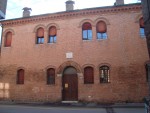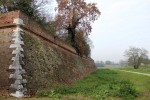Biagio Rossetti (1444-1516)
Brought to international attention by Bruno Zevi in 1960, for centuries Biagio Rossetti was considered the mastermind of all architectural undertakings in Ferrara under the House of Este in the fifteenth and sixteenth centuries. However, his role has been put into perspective thanks to recent historical studies.
Life events
Born in 1444, the son of a tailor named Andrea, Biagio Rossetti would become Ferrara's leading architect during the Renaissance. Having held the position of engineer for the Ufficio Munizioni e Fabbriche della Camera Ducale (Munitions and Factories Office of the Ducal Chamber) since 1483, Rossetti was tasked with overseeing the city's main urban and suburban construction sites until the 1510s, as well as most of the work commissioned in the territories of the Ducal state (including the Garfagnana, Modenese, Reggiano and Polesine regions, the latter of which lies north of the Po).
With particular talent and expertise in hydraulics, much of the religious architecture of Ferrara is attributed to Rossetti, including the bell tower of the church of San Giorgio (c. 1485), the basilicas of San Francesco and Santa Maria in Vado (1494-1498) and the apse of the cathedral (1498-1499). Meanwhile, with regard to military and civil structures, his catalogue of works includes the entire city walls (1495-1506), his private residence at no. 152 of the still-existent Via XX Settembre (1490-1498), the Palazzo Costabili (1496-1503), which is home to the National Archaeological Museum, the Palazzo dei Diamanti (1494-1496) and Piazza Ariostea (1494-1495), which is still present today - the heart of the Addizione Erculea ( Erculean Addition) area of urban expansion which he supervised as architect-engineer.
Numerous sacred, public and noble buildings that no longer exist are also attributed to Rossetti, as well as some for which he may or not have been responsible but which have been credited to him in the absence of documents proving otherwise (such as the church of the Certosa). He died on 16 September 1516 and was buried at the church of Sant'Andrea; his tomb has been missing since 1878. Rossetti had two sons and three daughters with his wife Elisabetta Flornovelli: Nicolò, Caterina, Ilisia, Girolamo and Margherita.
What happened to his tomb?
Having to adapt the deconsecrated church of Sant’Andrea for use by the Artillery Regiment, the Municipal Authority of Ferrara authorised the exhuming of all those buried there in May 1878. Their remains were transferred to other locations in a hundred or so urns and coffins, many of them hundreds of years old. According to the exhumation descriptions found by Giovanni Vincenti in the collections of the Historic Archive of Ferrara, which he compiled in 1909-1911 among the columns of La Rivista and La Gazzetta Ferrarese, Rossetti's bones were interred along with those of the architect Alberto Schiatti and painter Giacomo Parolini in February 1889 at the Certosa cemetery. Their exact location was not marked visually in any way, though it was said to be eleven meters from the Pantheon and four meters from the parallel lines of the large road. The slab of stone incised with Rossetti's epigraph was with the authorisation of the Engineering Office of Ferrara, padding the coffers of the administration. What headstone might he be referring to, considering that the commemorative marble plaque with the wording Blasius Rossettus languentis architecturae instaurator mentioned first by Marc’Antonio Guarini in his 1621 Compendio is no longer mentioned in the sources after 1735, when Ferrante Borsetti mentions the elogio eiusdem sepulchri in Templo domini Andreae Ferrariae in the Historia Almi Ferrariae Gymnasii for the last time? If we start with the collection of the Iscrizioni Sepolcrali e Civili di Ferrara (Sepulchral and Civil Inscriptions of Ferrara) compiled by Cesare Barotti in 1760, updated in 1776 with the addition of church floor plans, the section dedicated to the Augustinian church of S. Andrea in the first volume includes the tomb of Count Alessandro Rossetti di Valdabero, marked with the number 35 at the centre of the transept, bearing the year of 1618. Meanwhile, a generic grave of another noble branch of the Rossetti family is indicated by the number 77 at the base of the intrados of the third chapel in the left nave, i.e. the same location for Biagio Rossetti's tomb as mentioned by Guarini.
The disappearance indirectly ascertained by Barotti is undoubtedly confirmed a few years later in Antonio Frizzi’s Memorie, which defined Guarini's epitaph as ‘lost’. Yet in 1773 and in 1819, both Giuseppe Antenore Scalabrini and Marchioness Ginevra Canonici highlighted Rossetti, Schiatti and Aleotti among the ‘famous architects’ buried there. Similarly, a dossier published in 1909-1911 states that the original epigraph, ordered by Girolamo Rossetti immediately after the death of his father Biagio, was sold. They are interconnected contradictions of great importance that couldn’t be further from the gaudiness of the public honours paid to the remains of Giovanni Battista Aleotti, unearthed from the Cappella Del Santissimo Sacramente on 1 September 1878 and transferred to a new wooden casket. Temporarily kept at the Certosa Charterhouse, on 7 September Aleotti's coffin was placed atop a wagon covered in garlands to be pulled by horses throughout the entire city. Once at Porta Reno, with the mayor, city council members, religious figures and ‘Representatives of Society’ in attendance, final farewells were said before the departure of the coffin for Argenta, the city where Aleotti was born. With ‘solemn pomp’, the Santuario della Celletta received not only the mortal remains of the architect, but also the ark (the chest) and the marble slab from the tomb in Ferrara. It bore a long inscription exalting his humanistic gifts as an expert in Vitruvian teachings in addition to military engineering and hydraulic techniques. The exhumations of Rossetti and Aleotti couldn’t be more different, directly proportional to the degree of awareness that the community of local scholars had about their careers.
Bibliography
- Giovanni Vincenti, Le ossa e le lapidi sepolcrali di Biagio Rossetti e di altri illustri ferraresi in «La Rivista» 11 aprile 1909
- Giorgio Padovani, Biagio Rossetti in «Atti e Memorie della Deputazione Provinciale Ferrarese di Storia Patria», vol. XXIX, Ferrara 1931
- Bruno Zevi, Biagio Rossetti architetto ferrarese. Il primo urbanista moderno europeo, Einaudi, Torino 1960
- Andrea Marchesi, Marialucia Menegatti, «Grande così quanto forse ignorato»: omaggio a Biagio Rossetti, «Ferrariae Decus. Studi-Ricerche», 33, 2018
- AA. VV., Biagio Rossetti e il suo tempo, Atti del convegno (Ferrara, 24-26 novembre 2016), Ginevra Bentivoglio Editoria, Roma 2018
- Andrea Marchesi, Cronologia rossettiana, in Francesco Ceccarelli, Andrea Marchesi, Maria Teresa Sambin De Norcen (a cura di), Biagio Rossetti e il suo mito, Bononia University Press, Bologna 2019
- Andrea Marchesi, Biagio Rossetti nei documenti, tra smentite, conferme e nuove rivelazioni, in Francesco Ceccarelli, Andrea Marchesi, Maria Teresa Sambin De Norcen (a cura di), Biagio Rossetti e il suo mito, Bononia University Press, Bologna 2019
Sitography
- http://www.treccani.it/enciclopedia/biagio-rossetti_%28Dizionario-Biografico%29/
- https://biagiorossetti500.it/
- https://www.biagiorossetti.it/
Fototeca
Related Themes
Compiling entity
- Assessorato alla Cultura e al Turismo, Comune di Ferrara




